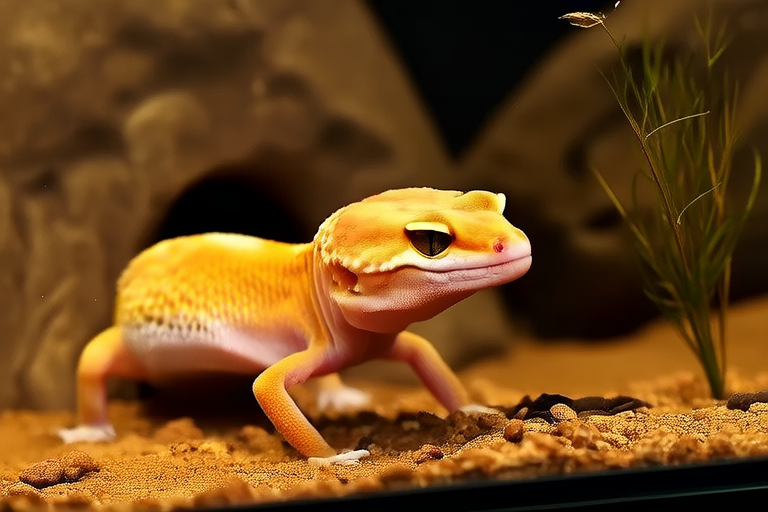Leopard Gecko Care Made Simple: A Beginner’s Guide
Welcome to your comprehensive guide on caring for leopard geckos! If you’re a first-time owner or considering adopting one of these fascinating reptiles, you’ve come to the right place. Leopard geckos are popular pets due to their relatively low maintenance needs and engaging personalities. This guide will walk you through setting up the perfect habitat, feeding them appropriately, handling them safely, and recognizing signs of good health.
Habitat Setup
Tank Size
The ideal enclosure for a single adult leopard gecko is around 20 gallons. For two geckos, consider a 40-gallon tank to ensure they have enough space to move around comfortably. A larger tank also helps maintain better temperature gradients, which are crucial for your gecko’s well-being.
Substrate
Selecting the right substrate is vital for your gecko’s health. Avoid loose substrates like sand or wood shavings as they can lead to impaction if ingested. Instead, opt for paper towels, reptile carpet, or eco-friendly paper bedding. These options are safe, easy to clean, and provide a suitable environment for your pet.
Hiding Spots
Leopard geckos are nocturnal creatures that need hiding spots to feel secure. Include at least two hides in the tank: one on the warm side and another on the cooler side. This allows your gecko to regulate its body temperature effectively. You can use commercially available hide boxes or create DIY versions from small plastic containers with entrance holes cut out.
Temperature and Humidity Requirements
Maintaining the correct temperature gradient within the tank is essential. Use a heat mat or under-tank heater placed on one side of the enclosure to create a warm area between 88°F and 92°F (31°C – 33°C). The cool side should be around 75°F to 80°F (24°C – 27°C). Invest in a reliable thermostat to control these temperatures accurately.
Humidity levels should be kept low, ranging from 30% to 40%. Leopard geckos thrive in dry conditions, so avoid misting the tank. Instead, provide a shallow water dish for drinking. Regularly check the water bowl to ensure it remains clean and free of contaminants.
Diet Specifics
Types of Food
A balanced diet for leopard geckos consists mainly of insects such as crickets, mealworms, dubia roaches, and waxworms. Offer a variety of prey items to ensure your gecko receives all necessary nutrients. Gut loading the insects before feeding them to your gecko enhances their nutritional value. Dust the insects with a calcium supplement without vitamin D3 twice weekly and a multivitamin once a week.
Feeding Frequency
Feed juveniles daily, reducing to every other day as they reach adulthood. Adults typically require three to five appropriately sized insects per feeding session. Monitor your gecko’s weight and adjust the amount accordingly. Overfeeding can lead to obesity, while underfeeding may result in malnutrition.
Handling Tips
Leopard geckos generally tolerate gentle handling but should never be handled roughly. Start by letting your gecko become accustomed to your presence before attempting to handle it. Gently scoop it up from underneath, supporting its entire body. Always wash your hands before and after handling to prevent the spread of bacteria.
Avoid handling your gecko immediately after eating or during shedding periods, as these times can cause stress. Also, never grab your gecko by its tail, as it may drop it as a defense mechanism. While the tail will eventually grow back, it won’t look the same as the original.
Common Health Issues
Recognizing potential health problems early is key to keeping your leopard gecko healthy. Common issues include metabolic bone disease (MBD), caused by calcium deficiency; respiratory infections due to improper humidity levels; and impaction from ingesting substrate. Regular vet visits can help catch these issues before they become serious.
If you notice any unusual behaviors, such as lethargy, loss of appetite, or difficulty moving, consult a veterinarian specializing in reptiles. Early intervention often leads to successful treatment outcomes.
Signs of a Healthy Leopard Gecko
A healthy leopard gecko exhibits several positive signs:
- Active and alert demeanor
- Clear eyes and nostrils
- Smooth skin with no visible cuts or abrasions
- Regular bowel movements
- Healthy weight without signs of obesity or emaciation
Monitoring these indicators regularly will give you insight into your gecko’s overall health status. Any deviations from normal behavior warrant further investigation.
Resources for Further Learning
Becoming an expert on leopard gecko care takes time and dedication. To deepen your knowledge, consider joining online forums dedicated to reptile enthusiasts. Books written by experienced herpetologists offer valuable insights into advanced husbandry techniques. Additionally, attending local reptile expos provides opportunities to interact with professionals who can answer specific questions about your pet.
Remember, every leopard gecko is unique. Pay close attention to your individual animal’s preferences and adjust care practices accordingly. With proper attention and love, you’ll enjoy many years of companionship with your new friend.
